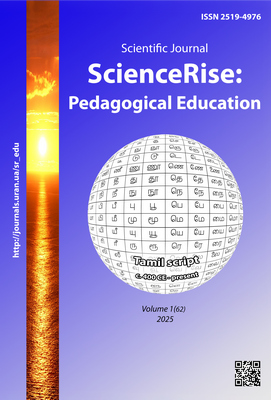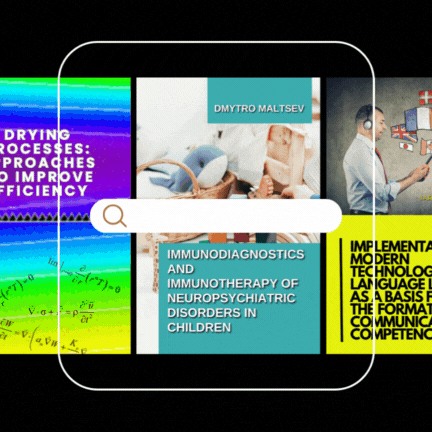Interdisciplinary connections as a way to overcome educational losses in the natural science educational field
DOI:
https://doi.org/10.15587/2519-4984.2025.326124Keywords:
interdisciplinary connections, educational losses, natural science educational field, integrated lessons, knowledge integration, scientific worldview, natural sciencesAbstract
The article explores the role of interdisciplinary connections as an effective means of overcoming educational losses in the natural science educational field. The relevance of the study is determined by significant changes in the educational environment, caused by the COVID-19 pandemic and martial law in Ukraine, which have led to a decline in education quality and increased learning gaps. The purpose of the work is to substantiate the effectiveness of interdisciplinary connections for enhancing students' cognitive activity, forming a scientific worldview, and addressing educational losses. The article examines the theoretical foundations of interdisciplinary connections and their impact on the educational process. A model for integrating interdisciplinary connections is proposed, which includes conducting integrated lessons, using project methods, and implementing interactive technologies. Examples of knowledge integration from biology, chemistry, and physics are provided, demonstrating the effectiveness of this approach in increasing students' motivation and improving their academic performance. Interdisciplinary connections contribute to the activation of cognitive activity, the development of critical thinking, and the formation of a holistic natural science worldview. The article includes practical recommendations for teachers on implementing interdisciplinary connections in the educational process, which is especially important in current conditions. Future research plans to scientifically evaluate the effectiveness of the proposed model of integrating interdisciplinary connections in the educational process to address educational losses
References
- Sipii, V. V. (2023). Osvitni vtraty zdobuvachiv zahalnoi serednoi osvity u formuvanni eksperymentalnykh vmin y shliakhy yikh kompensatsii. Materialy Vseukrainskoi naukovo-praktychnoi konferentsii. Problemy realizatsii dydaktychnykh funktsii navchalnoho fizychnoho eksperymentu v umovakh intehratsii shkilnoi pryrodnychoi osvity. Uman, 78–81.
- Pro zatverdzhennia Rekomendatsii slukhan u Komiteti na temu «Osvitni vtraty y osvitni rozryvy na rivni zahalnoi serednoi osvity: vymiriuvannia ta mekhanizmy podolannia» (2023). Rishennia Komitetu Verkhovnoi Rady z pytan osvity, nauky ta innovatsii. Available at: https://kno.rada.gov.ua/uploads/documents/38605.pdf
- Bereiter, C. (2013). Principled Practical Knowledge: Not a Bridge but a Ladder. Journal of the Learning Sciences, 23 (1), 4–17. https://doi.org/10.1080/10508406.2013.812533
- Maglaughlin, K. L., Sonnenwald, D. H. (2005). Factors that Impact Interdisciplinary Natural Science Research Collaboration in Academia. The 10th International Conference of the International Society for Scientometrics and Informetrics. Stockholm, 499–508.
- Beaver, D. (2001). Reflections on scientific collaboration and its study. Scientometrics, 52, 365–377. https://doi.org/10.1023/a:1014254214337
- Klein, J. T. (1994). Finding interdisciplinary knowledge and information. New Directions for Teaching and Learning, 58, 7–33. https://doi.org/10.1002/tl.37219945803
- Salter, L., Hearn, A. (1997). Outside the lines. Montreal: McGill-Queen's University Press, 216. https://doi.org/10.1515/9780773566217
- Dyachenko, A., Mukanova, R., Erkibayeva, M. (2024). Integration of interdisciplinary connections between chemistry, physics, and biology in the education of secondary school students. International Journal of Educational Reform. https://doi.org/10.1177/10567879241290180
- Vaskivska, H. (2015). Mizhpredmetnist yak neobkhidna umova modernizatsii zmistu osvity. Suchasni tendentsii rozvytku osvity i nauky v interdystsyplinarnomu konteksti. Uzhhorod – Drohobych: Posvit, 91–92.
- Chaus, H., Kocherha, Y., Romanets, O. (2022). The improvement of teachers’ information-digital competence in the field of natural sciences education as the basis of quality distance learning. Scientific Journal of Khortytsia National Academy, 7, 35–43. https://doi.org/10.51706/2707-3076-2022-7-4
Downloads
Published
How to Cite
Issue
Section
License
Copyright (c) 2025 Maria Nekrasova, Hanna Chaus, Volodymyr Prokuda

This work is licensed under a Creative Commons Attribution 4.0 International License.
Our journal abides by the Creative Commons CC BY copyright rights and permissions for open access journals.
Authors, who are published in this journal, agree to the following conditions:
1. The authors reserve the right to authorship of the work and pass the first publication right of this work to the journal under the terms of a Creative Commons CC BY, which allows others to freely distribute the published research with the obligatory reference to the authors of the original work and the first publication of the work in this journal.
2. The authors have the right to conclude separate supplement agreements that relate to non-exclusive work distribution in the form in which it has been published by the journal (for example, to upload the work to the online storage of the journal or publish it as part of a monograph), provided that the reference to the first publication of the work in this journal is included.








